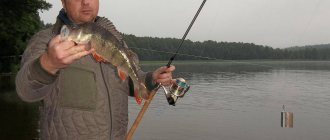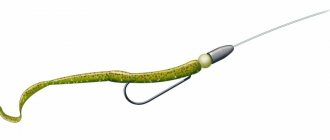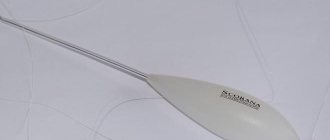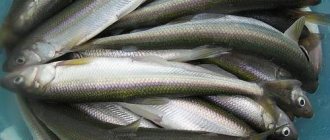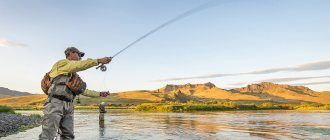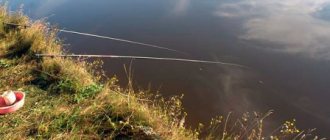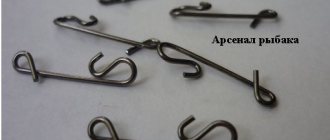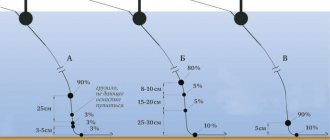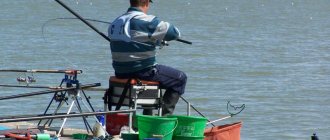One of the first problems that fans of feeder fishing face is how to choose a feeder rod, and not only the convenience during the fishing session, but often its result, depends on its correct solution.
Fishing with bottom gear is considered the most popular in our country, and the feeder is the most catchy and versatile bottom gear. Before we talk about how to choose the right feeder rod, let’s outline the advantages of this gear and the conditions in which it is used.
The advantages of fishing with a feeder
The invention of the feeder played a big role in the development of bottom fishing, and fishermen liked it immediately after its appearance.
The feeder is used to catch:
- rivers, with current;
- inland waters, without current;
- sea.
That is, in almost any conditions, this bottom tackle provides results. The amateur donka is a simple tackle that has been used by fishermen for decades, but it has limitations on the fishing range and the size of the fish caught.
It is difficult to bring fish weighing more than 10 kg onto the bottom without a rod, since the tackle simply will not hold up, or the angler will cut his hands on the fishing line. Using a feeder rod in this case solves all problems, and besides this, the feeder has the following advantages:
- no need for a bite alarm;
- fishing is carried out at a distance of 100+ meters;
- with the help of one rod they catch as many fish as with several classic donks;
- the fishing point is constantly supplemented with bait from feeders;
- any bottom nozzles are used;
- all non-predatory fish are caught;
- self-cutting and sliding equipment is used.
With the help of a feeder, they catch both small roach and large carp or silver carp at both a distance of 40 and 120 meters. The fisherman does not need to monitor several donks at once, because more fish are caught with one feeder rod.
The pace of feeder fishing involves re-casting the tackle every 3-5 minutes, although this period varies depending on the conditions. After the tackle is thrown into the water, the line is tensioned so that the tip of the rod (quivertip) is bent. When a fish bites, the position of the quiver tip changes and the fisherman understands that he needs to hook.
Small fish are caught on the feeder:
- roach;
- blue;
- sprat;
- bull;
- white bream.
But the catch also includes large trophies:
- carp;
- white and black cupids;
- silver carp;
- line.
Even catfish are caught on a feeder, but for this the most durable forms and appropriate installations are used. Fishing for crucian carp and bream using feeder rigs is very popular; in general, any peaceful fish can be successfully caught using this bottom rig, so its popularity is not surprising.
Thanks to the use of a feeder, the fishing point is constantly fed with new portions of bait, and this, in turn, attracts fish and keeps it in one place.
Using a variety of baits and baits makes it possible to fish with feeder gear throughout the open water season and even from the ice in winter.
And if during periods of inactive fish and weak bite, sliding rigs turn out to be catchy, then the summer options are self-hooking, which saves the fisherman from the need to make a clear hook in time.
Naturally, for catching small fish and trophy carp, feeder rods with different characteristics are needed, and therefore most feeder anglers have several forms in their arsenal, for different conditions.
Advantages of using feeder rods
- All feeder rods have a replaceable tip, which is characterized by high strength.
- Considering that this type of rod can have large and voluminous feeders, the fisherman always has the opportunity to deliver the bait to the very bottom of the reservoir.
- Feeder rods can have a large number of rings, which makes it possible to evenly distribute the load on the device.
- Due to the fact that there are several small rings at the end of the rod, and the tip itself is made thin and flexible, the fisherman will be able to see any contact of the fish with the nozzle. When purchasing a feeder rod, up to 5 of the same tips are always included in the kit. Their main difference is the level of rigidity, which makes it possible to catch fish of various sizes and have maximum sensitivity of the rod.
- Despite the sufficient length of the rod (up to 5 meters), its test weight is no more than 60 grams.
- Feeder rods make it possible to cast gear far and provide excellent resistance when hooking large fish.
Wise choice of feeder rod
Despite the fact that each situation is individual, there are general criteria for choosing a feeder form.
This:
- fishing conditions, type of reservoir;
- anthropometric data of the fisherman;
- expected size of fish in the catch;
- the distance over which the installation is supposed to be thrown;
- weight of the thrown cargo;
- ease of use while fishing;
- quality of production of the feeder form;
- cost of the rod.
Each angler has a certain purchase budget and, depending on this amount, considers which feeder to choose. But even if the budget is unlimited, this does not mean that you need to buy the most expensive fishing rod and it will become universal for all occasions.
Of course, the higher the price of the feeder, the higher the quality of its manufacture, but this does not mean that the budget form is no good and you cannot catch trophy fish with it. Many anglers with different incomes have a need to purchase feeder equipment, including fishing rods, so fishing equipment manufacturing companies try to offer a wide range of feeders, as they say, for every taste and color.
And this is not a standard phrase, since the feeder should not only fit well in the fisherman’s hand, but also look aesthetically pleasing and attractive. Such is the nature of the fisherman - he should like the chosen rod from an aesthetic point of view.
Expert opinion
Evgeny Zhirkov
Feeder fishing expert
You need to choose from stores that have been tested by time, purchases and reviews. Super expensive sticks, of course, before buying, the angler should hold them in his hands and “taste” them.
Budget and mid-range forms are increasingly being purchased in online stores.
The choice there is much richer than usual, and the prices are cheaper (since there is no markup made up of the costs of rent, wages, maintenance, etc.).
But these are still secondary aspects, and the primary one will be a professional assessment of the performance characteristics of the feeder form in the first place, and an attractive appearance second.
Useful tips
To achieve high efficiency in feeder fishing, follow a few simple tips:
- if the feeder is large and heavy, make long casts using a shock leader in order to prevent the base line from breaking;
- add the bait to the bait. For example, worms can be chopped and added to bait;
- in spring and autumn, most fish species are more active on animal baits, while in summer vegetable baits are most effective;
- The fishing location should be selected experimentally, including testing the depth and topography of the bottom. Large individuals are usually found in pits;
- Before actually catching, feed the fish well. To do this, throw only the feeder filled with food 10-15 times. There are special models of feeders for pre-baiting.
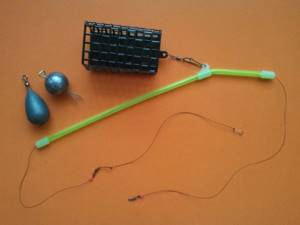
Picker
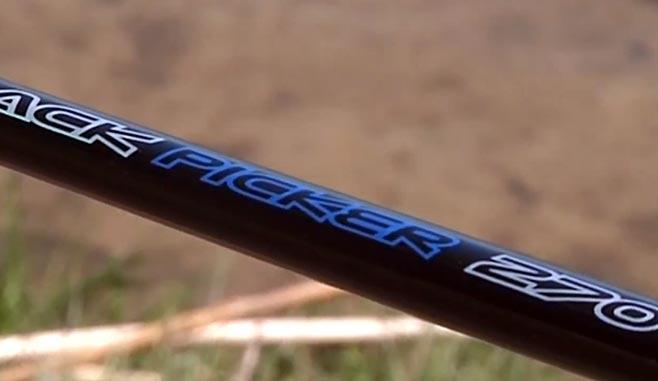
Expert opinion
Evgeny Zhirkov
Feeder fishing expert
Bottom fishing does not always involve long casts of heavy feeders; conditions vary and often fishing at a distance of up to 40 meters is the most effective. As you know, fish go to the shore to feed, under overhanging tree branches or thickets of reeds, and if the fisherman manages not to make noise on the shore, a good fishing result is guaranteed.
For fishing at close ranges, there is no point in choosing a rigid feeder rod, which creates certain inconveniences when casting under the near edge. It’s not that such a feeder with a solid test will not cope with the task, but there is simply no need for it, especially if small fish are caught.
It’s not even interesting to fish out a small bream or roach on a feeder with a dough of 120 grams or more; there is no pleasure in it for the fisherman. Therefore, for fishing at short distances with light feeders, a picker is chosen.
A picker rod is a type of feeder with a small test for light feeders. The length of the picker rod varies from 210 to 300 cm, weight up to 60 grams. Although in the last 3–5 years pickers with a weight of up to 120 grams have appeared, for fishing on the current, gear with feeders weighing 70–80 grams is enough. This is due to the development of new high-strength materials that can withstand severe loads.
Initially, a picker is a two-legged feeder-class rod with a test weight of 40–60 grams, up to 270 cm long, intended for fishing at a distance of up to 50 meters. The principle of pickerel fishing is no different from feeder fishing, except that this is delicate fishing, not designed for large trophies.
They fish with a pickerel with a line, because at short distances the stretchability of the monofilament does not provide any advantages, therefore, when choosing a pickere rod, it is important that the quality of the guides corresponds to the expected load when casting and retrieving.
Small rivers and streams, ponds and overgrown lakes are those bodies of water where pickerel fishing is most effective and justified. Anyone who wants to get involved in fishing with feeder rigs is recommended to start with a picker in order to understand and appreciate all the advantages of fishing with a quiver tip rod.
The light weight of the blank, soft tips, and thin lines help you experience the beauty of fishing with feeder rigs and catch great fish.
The picker is used to catch not only small fish, but also carp and medium-sized carp, and the rod copes well with the load.
Material about pickerel fishing can be read here ▶
Choose a picker rod by:
- length;
- form material;
- test;
- cost.
Salmo rods are considered the best pickers in Eastern Europe, in terms of price-quality ratio, and among them:
- Elite Picker 40.
- Team Salmo Energy Picker 40.
- Team Salmo Tournament 40.
- Team Salmo Tournament 50.
Which feeder rod is better to buy?
An important selection criterion is the class of equipment, which determines the type and weight of prey. The higher it is, the heavier the fish the fisherman can catch. At the same time, fishing for large trophies is ensured by a slow system. For fishing in reservoirs with strong currents, you need to buy a rod with good test. Beginner fishermen will benefit from inexpensive or universal models of medium weight that hold the load well. The kit should include tips of different sensitivity, which ensures successful fishing in any conditions. The following recommendations will help you buy a good device:
- The best feeder rod for beginner fishermen is Siweida Force 2471530;
- The cheapest and most compact model is Kaida Spirado0/60-150 (302-300);
- The best tackle in terms of price/quality ratio is Daiwa Heavy Feeder (TDHF14-AD);
- Users' choice – Salmo Sniper Feeder 90 3.60 (4013-360);
- The device with the widest test range is Daiwa Ninja X Feeder (11605-330);
- The longest feeder is Shimano Beastmaster Dx Feeder (Bmdxlc150lfdr);
- In terms of ease of use in difficult conditions, the leader is Zemex Rampage River Feeder 13ft 150g Fast (RE-013-150);
- Fans of braided cord are recommended to choose Volzhanka Optima 3.9 m up to 120 g (041-0014).
Not every novice angler knows how to choose a feeder rod. Experts recommend starting with studying the characteristics and user reviews, which highlight the pros and cons of each model.
Feeder rod length
When purchasing a feeder for specific fishing conditions, you need to choose the right rod length, which depends on several factors. On the one hand, a long and rigid blank makes it easier to throw heavy feeders over long distances.
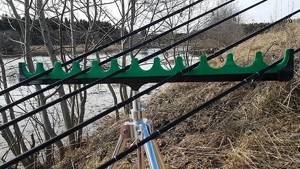
On the other hand, a feeder that is too long is inconvenient when fishing at short distances, and this happens often. The height of the fisherman also matters, because not every fisherman is comfortable casting with a long rod, and if we take into account the high frequency of recasts, then even more problems arise.
Therefore, the choice of feeder and its length is made taking into account:
- height of the fisherman;
- expected casting distance;
- weight of the feeders used;
- fishing conditions and equipment used.
If when fishing you use a feeder station that provides the necessary amenities, then in a sitting position even a physically strong and tall angler will not throw the tackle far.
But if the cast is performed in a standing position, the long rod shows all its advantages and the tackle flies 100 meters or more. Here, every additional foot of length (30 cm) plays a big role and adds 10–20 meters to the casting distance (depending on the physical strength and height of the angler). Therefore, long rods are chosen for long-distance fishing and their test weight should be at least 80 grams.
Such rods are heavier than the same picker and their sensitivity is lower, but these shortcomings are compensated by their sending power, which is important for long casting, reliability and comfort when fishing for a heavy trophy.
For fishing at distances up to 80 meters, the optimal feeder length is 11-12 feet (330-360 cm). For longer casting, choose feeders 13–14 feet (390–420 cm) long.
Even during one session, fishing conditions change, the wind interferes, and fishing points can change, so it is advisable to have feeder forms of different lengths in stock, suitable for different situations.
It is difficult and inconvenient to fish with a 420 cm long feeder at close range, as well as with a picker at long range, so it is better to take rods of different lengths with you when fishing and always be confident in your gear.
Test and classification of feeders
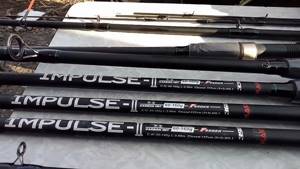
While everything is more or less clear with the concept of a feeder rod test, not all fishermen know what action is and how forms of different action differ. And before choosing the best feeder, you need to understand all the nuances. The rod test is considered to be the optimal mounting weight to be cast into the water.
If the weight of the feeder with bait is greater than the declared test form, then it will break during a force cast.
Manufacturers indicate a test rod with a margin of 20–30 grams, but it is better not to take risks and strictly follow the recommendations. Light rigs are also inconvenient to throw with a rod with solid test, as it will “fail” when casting. What type of rod test is usually indicated directly on the form and this is one of the important selection criteria.
For some feeder models, test limit values are indicated - maximum and minimum, most often in libra (1Lb - 327 grams). It is better for the fisherman to follow the manufacturer’s recommendations, then the rod will last for more than one year.
Experts divide five classes of feeder rods, and although this classification is very arbitrary, it helps to determine the right choice:
- ultra Light feeder – ultra-light;
- light feeder – light;
- medium feeder – medium;
- heavy feeder - heavy;
- extra heavy feeder - extra heavy.
This classification is recognized by manufacturers and a mark about the class of the feeder rod is placed on the form. Ultra Light feeder is designed for fishing with feeders weighing up to 40 grams in still water.
The length of such fishing rods does not exceed 3 meters and they are made from:
- carbon fiber;
- fiberglass;
- composites.
Ultralight rods are not designed for long-distance power casting. But in conducting exploratory fishing at close ranges, such forms show their best side.
The maximum length of the light feeder is 330 cm, and the test weight is up to 60 grams. Such parameters allow you to conduct comfortable fishing at distances of up to 60 meters, not only in lakes and stakes, but also on rivers. Inexperienced anglers should pay attention to forms of this class, because this is, in fact, a feeder rod for beginners and it is better to learn feeder fishing with it.
Medium feeder is the largest class of feeder forms. The length of the mediums is up to 360 cm, the test weight is up to 100 grams, and these are already solid characteristics that allow you to catch trophy fish at distances of up to 80 meters. The high sensitivity of medium-class feeders is important, and when fishing, they “knit” the fish well, preventing it from getting off the hook. Such rods can withstand forceful casting and are sensitive to the most “gentle” fish bites.
Heavy class feeders are aimed at catching strong fish on large rivers with turbulent currents, where their advantages are fully demonstrated. Test forms up to 120 grams, length up to 390 cm, fishing distance 120+ meters. High-quality heavy feeders are made of carbon, because this allows, along with reliability and power, to minimize the weight of the form and provide convenience when working with it.
Heavy class rods are also used for fishing on still commercial reservoirs, where there are definitely trophy fish, but to catch them, you need power casts over a long distance. The blank of the rod handles the jerks of trophy fish well and forgives the angler for possible mistakes when fishing.
Along with mediums, heavy feeders are very popular among fishermen and companies producing feeder equipment are trying to constantly expand their offer in this niche.
You need to understand that heavy class feeders are inconvenient for close-range fishing with light feeders. The load on the rod must correspond to its class.
Feeder rods of the extra heavy are the most powerful equipment for fishing in difficult conditions. If you have to fish on a river with a strong current, you need to use heavy feeders that ensure that the food is thrown at the same point all the time, because they are not carried away by the flow of water. But to cast a heavy feeder you need a powerful blank that can withstand heavy loads. Extra-heavy feeders are the heaviest, but this is not surprising considering the tasks they perform.
The best inexpensive feeder rods
The cheapness of fishing equipment does not mean its low quality, since most well-known manufacturers produce budget versions of good devices. In a number of parameters they may be inferior to more expensive models, but even professionals confirm their reliability and functionality. Based on an analysis of user reviews, out of 10 nominees, 4 inexpensive fishing accessories were selected for the rating of feeder rods.
Kaida Spirado 3.0/60-150 (302-300)
Super heavy class plug rod. The size of the test allows you to use a load with bait weighing from 60 to 150 g. When finished, the length of the device is 3 m, during transportation it folds up to 1.1 m. The design with 3 sections is made of composite material. A type of holder involves fastening the coil using a rotating screw. 11 SIC rings are made of durable silicon carbide, which is valued for its lightness and good corrosion protection.
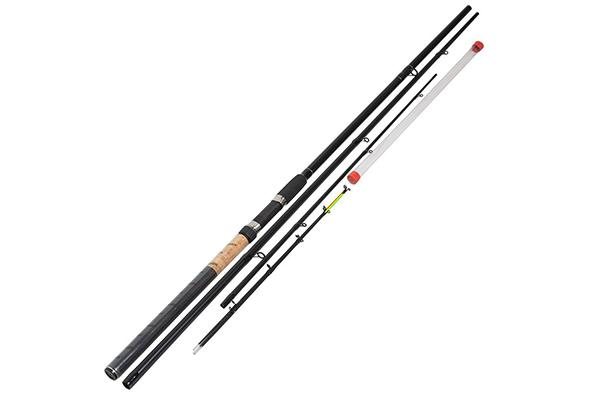
Advantages
- 3 replaceable whips included;
- Blank power;
- Assembly reliability;
- Casting distance;
- Strength of materials;
- Compactness.
Flaws
- Quality of fittings;
- Weight.
The model is recommended to be purchased by 80% of users for fishing in water bodies with medium current speed. They note a good level of feedback and high sensitivity of the tips. The disadvantages include the small diameter of the rings and the material of the plug.
Mikado Ultraviolet Heavy Feeder 420 (WA-319 420)
A rod with a medium-fast action is classified as a particularly heavy class model. The test is designed for the use of feeders weighing up to 120 g. The plug design consists of 3 sections, a walnut handle, and SIC rings, which have good anti-corrosion protection. The device length of 4.2 m provides a good casting distance. After assembly, it is 1.45 m, which may cause inconvenience during transportation.
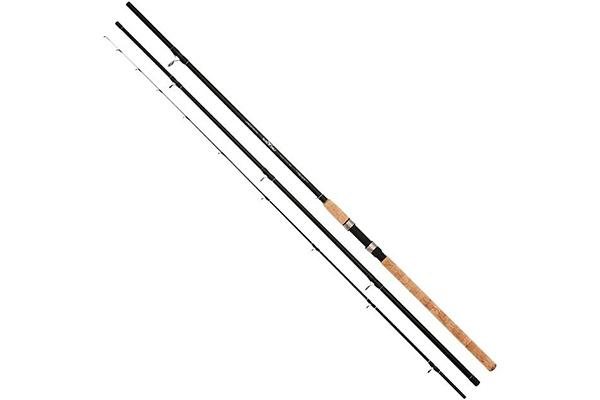
Advantages
- The blank is made of carbon fiber;
- The kit includes 3 replaceable whips of different sensitivity;
- Versatility;
- Build quality;
- Good feedback;
- Abundance of quivertypes;
- Comfortable handle.
Flaws
- Inconvenient location and fragility of the rings;
- Lack of markings on quivertypes.
Most reviews about the feeder rod are positive. Users confirm the effectiveness of fishing in still waters and on the current. The model works well for fishing, all jerks are transmitted, and when casting, the equipment flies exactly to the planned place.
Siweida Force 2471530
The device blank is made of a composite containing 75% carbon. It is also classified as a particularly difficult class. The test is designed for the use of feeders weighing up to 100 g. The kit includes SIC rings with anti-corrosion protection, 2 replaceable tops, a screw spool holder, and a neoprene handle. The characteristics of the nominee ensure effective fishing in reservoirs of any type. The length of the structure is 3 m.
Advantages
- Reliable assembly;
- Quality of materials;
- Ease;
- Compactness;
- Ease of use.
Flaws
- In terms of rigidity, the replacement whips differ little.
A good feeder rod for beginners. Users have no complaints about the build quality or functionality at this price. The advantages include a convenient case, which has compartments for each part of the device.
Rubicon Power Feeder 3.6/40-90
A powerful fast-action model designed for fishing in medium, fast currents using heavy equipment. The form is made of composite. The size of the test involves the use of feeders weighing 40 - 90 g. The design of 3 sections opens to a length of 3.6 m. When assembled, it decreases to 1.27 m, which increases the convenience of transporting the rod. Equipped with lightweight SIC guide rings, combination handle, screw type spool holder.
![]()
Advantages
- The kit includes 3 tips of different sensitivity;
- Efficiency of landing large prey;
- Anti-corrosion properties of the ring material;
- Light, sonorous form;
- Casting accuracy;
- Build quality.
Flaws
- Inconvenient arrangement of rings.
Users highly appreciate the characteristics of the budget nominee. They note the good durability, functionality, and ease of use of the device. The downside is that the first ring is installed close to the reel seat, which reduces the casting distance.
Build
Another important characteristic of the feeder is its structure. Many anglers do not fully understand what this concept is and what role it plays when choosing a feeder. In fact, action characterizes the rigidity of the rod and the ability of the blank to withstand loads.
The slow or fast action of the rod affects its “work” when casting, not only the tip, but also all other parts.
There are three types of structure:
- fast – fast;
- average – average;
- slow - slow.
When casting with a fast action rod, the tip and the upper bend bend, that is, about 30% of the length of the entire blank. It is believed that fast action feeders make it easier to accurately cast to the desired point, and as you know, this is an important condition for feeder fishing.
With each subsequent cast, the amount of bait in the swim increases, which serves as an additional factor in attracting fish. It is more convenient to force the catch of a trophy with a fast-forming feeder, and it can withstand heavy loads. But the fisherman needs to be careful, since the rod does not absorb the jerks of the fish well, and if the reel clutch is incorrectly adjusted, the equipment may break.
The medium action feeder bends to half the form when casting and retrieving, “forgiving” the angler for possible mistakes in the retrieving technique. Medium action rods are recommended for beginner fishermen who are honing their technique of working with a feeder blank.
Slow action rods bend along their entire length and perfectly dampen the jerks of the heaviest fish, which actively resists when fishing. It is more difficult to accurately cast with such a form, but it uses thin bases, cords and monofilament lines. The thinner the diameter of the base, the further the equipment flies after casting, so it is also impossible to say that “slow” feeders are used to fish only under the shore.
When purchasing, the rod's structure is determined using a special test, because not every manufacturer provides complete information. To do this, a load equal in weight to the test indicators is attached to the upper tulip. Gradually moving the form from a vertical to a horizontal position, the structure of the feeder is determined by eye.
Material of manufacture
Naturally, every angler wants the rod he buys to last more than one season and successfully cope with casting and landing all types of fish. Much here depends on the material from which the form is made, because its quality is the key to the reliability of the feeder. There were times when bamboo fishing rods were considered the best, but technology does not stand still and feeders are now made from:
- high modulus graphite;
- composite materials;
- fiberglass.
It is logical to assume that if there was one material that was ideal in all respects, then the alternative simply would not be used.
Therefore, it is necessary to evaluate materials for the manufacture of forms according to several parameters:
- strength;
- durability;
- price;
- weight;
- resistance to ultraviolet rays.
With minimal weight, rods made of high-modulus graphite are the strongest and most durable, and in this regard there are no complaints about them. But graphite blanks are fragile and sensitive to shock, so they must be used carefully and avoid mechanical damage.
Another bottleneck of carbon rods is the joints of the plug connections. If sand or dirt gets in, they are quickly destroyed, and repairing a graphite blank will not be cheap. In addition, the cost of carbon feeders is higher than all others, and not every angler can afford expensive equipment.
Composite feeder rods require less maintenance, cost less than graphite, and are durable and reliable. But their weight is greater than that of carbon ones, and for feeder fishing this is an important indicator. It is better to fish with a composite form using a rod pod or stands with alarms, since holding them in your hands for several hours is a very tedious task.
The cheapest feeders are made of fiberglass and they are also very popular among a certain group of fishermen. However, at a low cost, the rigidity and weight of a fiberglass blank is higher than that of carbon and composite blanks, and it is better to use it for a long session. Or, in any case, after casting, put the rod on the stands to save yourself from unnecessary hassle and physical exertion.
The durability of a feeder rod largely depends on storage conditions, so during transportation you need to use soft covers, and a separate one for each rod.
Types of feeder rod materials
The material of the rods affects the following: sensitivity, flexibility, weight, strength, durability, price.
Feeder forms are made from the following materials:
- Fiberglass.
- Carbon fiber.
- Composite
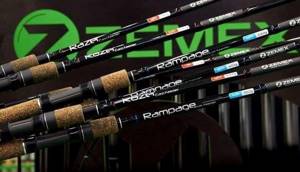
Fiberglass feeders:
- Low price;
- good flexibility;
- strength;
- durability;
- poor sensitivity;
- heavy weight.
Carbon fiber feeders (carbon):
- Very light;
- sensitive;
- high price;
- fragility.
Composite fishing rods combine fiberglass and carbon fiber. The result is something average in all respects at an average price.
Rings
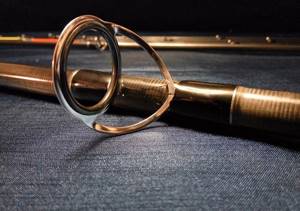
Not all fishermen pay attention to the material from which the feeder rings are made, and this is completely in vain. Considering that braided cords are often used as a base, situations arise when after several fishing trips they begin to become shaggy and even tear.
The point here is not the low quality of the braid itself, but the rings with which the feeder rod is equipped. Poor quality material of the guide rings causes damage to the cord even after minor loads. In inexpensive fiberglass feeders, the rings are not designed for braid at all and it is not surprising that the cord cuts through them when casting.
But silicon-coated metal-ceramic (SIC) rings are really capable of coping with significant loads, and for a long time.
So, when choosing a feeder, be sure to pay attention to the quality and material of the guide rings, and in the process of further use of the rod there will be no problems. Even if there is no corresponding marking on the form, you can find out what the rings are made of from the manufacturer’s catalog.
Quivertip
The tip of the feeder, or quivertip, plays a big role when working with tackle. It not only serves as a bite indicator, but also participates in casting and retrieving fish.
For quivertypes the following are important:
- material of manufacture;
- seat diameter;
- length;
- diameter of passage rings.
Each feeder rod is equipped with several quivertips (2–4) and it is advisable to find out from the catalog exactly how many there should be. Unscrupulous sellers often do not fully complete the feeder and instead of three tips they give two, or even one.
In the future, they sell the “extra” quivertypes separately, receiving additional profit. To prevent this from happening, you need to get all the information about the feeder you are interested in and know how many tips come with it. Each tip is characterized by dough (in ounces or grams) and is marked with the appropriate color.
Red is the hardest tip, green is the softest. The third type of tops, yellow in color, has an average test value. The rigidity (test) of the quiver tip is important when working with tackle, because after casting the angler tightens the line so that the tip bends.
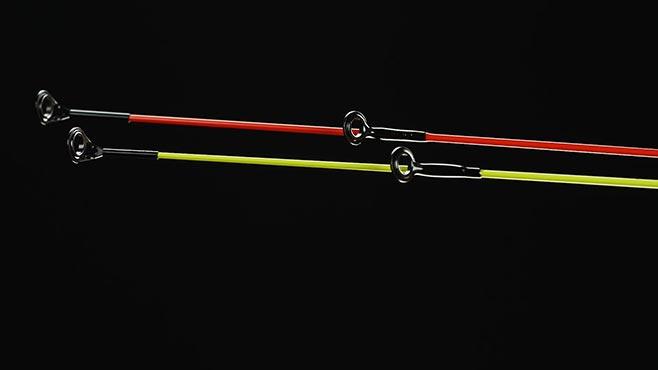
When fishing in the current, hard tips are used, in still water - soft ones. But everything is very individual and the selection of a quivertype of the required rigidity is done on the reservoir, depending on the specific conditions. Feeders of the middle and highest price categories are equipped with one carbon quivertip and two composite ones.
If the tip is broken, it is easy to get a replacement by contacting a fishing equipment store. When choosing, the main thing is that the diameter of the tip and the feeder seat coincide.
The rigidity and sensitivity of the tip depends on the material from which it is made.
A separate article on our website is devoted to quivertypes, we recommend reading ▶

